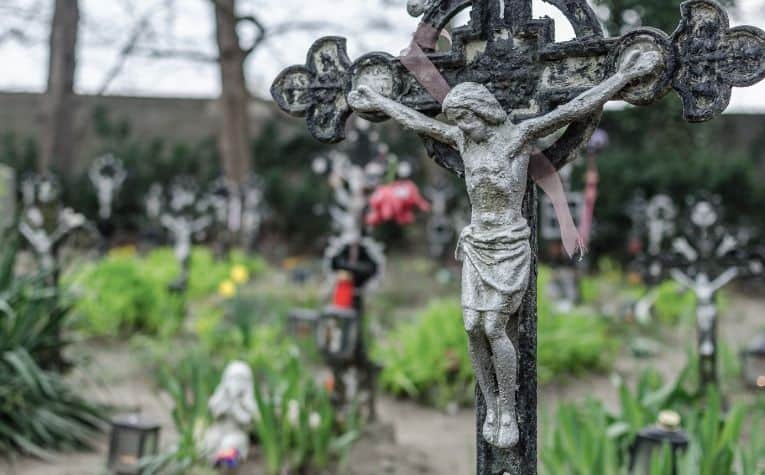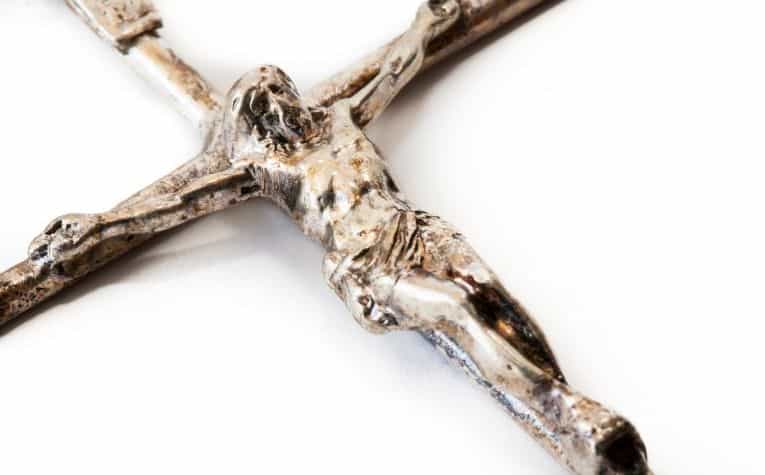A crucifix is one of the most recognizable images in the Christian faith. For those who embrace using a crucifix, it symbolizes the death of Jesus Christ for the forgiveness of their sin. However, other Christians avoid using the crucifix because they believe that the Bible instructs believers not to use such objects.
Baptists don’t use a crucifix because they believe it violates the second of the 10 Commandments about not using graven images. Idols, they argue, shouldn’t be in churches or on their jewelry. Baptists also believe that crucifixes fail to depict Christ’s victory over sin, which his resurrection accomplished.
Exactly how does a crucifix violate the second commandment, according to Baptists’ beliefs? Do other Protestant denominations reject it, too? Keep reading to learn more.
Also, see Are Baptists Allowed to Dance? to learn more about the tradition.

Does A Crucifix Violate the 2nd Commandment?
Baptists don’t have crucifixes in their churches or use them in decorations in their homes or on their jewelry because they believe the image violates the second of the 10 Commandments. What does the second commandment say exactly?
| Exodus 20:4 |
|---|
| “You shall not make for yourself an idol, whether in the form of anything that is in heaven above, or that is on the earth beneath, or that is in the water under the earth.” (NRSV, Catholic Edition) |
| “Thou shalt not make unto thee any graven image, or any likeness of any thing that is in heaven above, or that is in the earth beneath, or that is in the water under the earth.” (KJV) |
| “You shall not make for yourself a carved image, or any likeness of anything that is in heaven above, or that is in the earth beneath, or that is in the water under the earth.” (ESV) |
While Baptists apply these verses to using crucifixes, those who use the image in worship, as decoration, on pendants, and in other displays don’t believe they are breaking the second commandment. Those who use crucifixes don’t believe they are rebelling against God; they believe they are honoring him. (Also see Do Baptists Believe in Saints?)
Key term | crucifix: The English word “crucifix” comes from the Latin word “crucifixus,” which combines “cruci” and “fix,” meaning “one fixed to a cross.”
How Do Baptists Interpret the Second Commandment?
Baptists believe that Christians should obey the 10 Commandments. They don’t always agree on certain applications, like how a person should observe the Sabbath, but they agree that the moral foundation of the instructions applies to the age of Israel and the age of the Church. (Also see Here’s What Baptists Believe About Salvation)
Baptists believe that using crucifixes — which they understand to be idols, graven images, or carved images — offend and dishonor God’s nature in these ways:
- Crucifixes hide God’s glory: Images of Christ’s death on the cross may reflect a moment in history, but they obscure God’s glory. The term “glory” describes God’s unending beauty that leads people to know and worship him. “Glory” in the Bible describes God’s character and deeds. To Baptists, crucifixes dim the light of God’s beauty.
- Crucifixes hide God’s victory: The clear teaching of the New Testament is that Christ rose from the dead three days after his crucifixion. The Gospel stories conclude with Christ’s resurrection, not his death. His body no longer hangs on a cross because he physically rose to new life. To Baptists, crucifixes don’t tell the end of the story. However, empty crosses serve as a reminder of Christ’s resurrection.
- Crucifixes hide God’s character: To Baptists, one of the great dangers of images of Christ is that the person imagines the depiction while in prayer. If a person imagines God in their mind the way he is portrayed in a piece of art or on a wall decoration, or on a necklace, that is idolatry. Some may object, “but that image only represents Christ,” to which Baptist theology would say, “a representation isn’t good enough because it’s not God.”

Do Other Protestants Use Crucifixes?
Crucifixes are most common in the Roman Catholic and Eastern Orthodox traditions, where they are found in church sanctuaries, in pictures and paintings, and on personal items like jewelry and rosary beads. (Also, see Baptists vs. Catholics: What’s the Difference?)
Key term | rosary: The rosary is a devotional prayer in Catholicism, which includes the Hail Mary and the Lord’s Prayer. The word also describes the string of beads that Catholics use to aid them in praying.
Most Protestant traditions reject using crucifixes because they believe it is a violation of the second commandment and for the other reasons already mentioned.
However, some Lutheran and Anglican churches utilize crucifixes in corporate worship and for personal use, such as prayer. (Also, see Baptist vs. Lutheran: What’s the Difference?)
Crucifixes in Lutheranism
The 16th-century German Reformer Martin Luther established using crucifixes in Lutheran churches. Luther believed that people could use images of Christ incorrectly, but there are right ways to use them, too. Luther believed that an image of Christ wasn’t inherently corrupt.
He wrote, “Luther taught that a crucifix or an image, whether it be of God or Mary, for example, can be kept to remember a person or an event. In other words, Luther distinguished between using images to remember and using images to worship.”
He continues, “[M]y image breakers must also let me keep, wear, and look at a crucifix or a Madonna . . . as long as I do not worship them, but only have them as memorials.” (Ibid., 86, 88)
He concludes, “But images for memorial and witness, such as crucifixes and images of saints, are to be tolerated . . . And they are not only to be tolerated, but for the sake of the memorial and the witness they are praiseworthy and honorable . . .” (Ibid., 91)

John Calvin Opposed Using Crucifixes
The French Reformer John Calvin, who established the Presbyterian church and articulated much of Reformed theology for the Protestant church, agreed with Luther on many things, but using crucifixes wasn’t one of them. Like Baptists, Calvin believed images of God hide his glory:
“We think it unlawful to give a visible shape to God, because God himself has forbidden it, and because it cannot be done without, in some degree, tarnishing his glory.” (The Institutes of the Christian Religion, I, 11:12)
Like Baptists, Calvin establishes his argument in the 10 Commandments: “In the Law, accordingly, after God had claimed the glory of divinity for himself alone, when he comes to show what kind of worship he approves and rejects, he immediately adds, ‘Thou shalt not make unto thee any graven image, or any likeness of any thing that is in heaven above, or in the earth beneath, or in the water under the earth,’ (Exod. 20:4). By these words he curbs any licentious attempt we might make to represent him by a visible shape…” (Ibid, I, 11:1)
In a sermon on Deuteronomy, Calvin implored people not to use images of Christ: “Should we have portraitures and images, whereby only the flesh may be represented? Is it not a wiping away of that which is chiefest in our Lord Jesus Christ – that is, to wit, of His Divine Majesty? Yes!” (Sermon on Deuteronomy 4:15-20)
While Baptists find agreement with Calvin on the use of crucifixes, they have a disagreement with him about the extent of the second commandment’s prohibition. Calvin, unlike Baptists, believed that Christians shouldn’t utilize empty crosses corporately or privately either.
Baptists Revere the Cross of Christ
Some people may conclude that because they don’t use crucifixes, they don’t value the death of Christ. On the contrary, historically, Baptists have been staunch defenders of the centrality of the cross for the atonement of sin. Salvation for sinners isn’t possible without the cross of Christ, according to Baptist theology. (Also see Do Baptists Believe Jesus is God?)
Rather, it’s because Baptists think so highly of the cross that they don’t utilize its image in church or in their personal life. Therefore, Baptists don’t reject the crucifix because they reject the importance of Christ’s death; they revere the death of Christ and don’t want to reduce its significance to an image. (Also see Can Baptists Dance?)
Please see the related articles below.
References:
[1] Source
[2] Source
[3] Source
Related Questions
Baptist and evangelical churches are numerous in America, and the influence of each tradition has also spread to different continents and countries. As a result, many people have heard the terms...
The Baptist tradition is one of the largest branches of Christianity in America and around the world. Historically, some Protestant denominations have prohibited their members from activities like...
